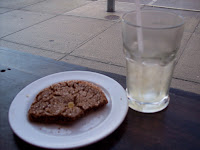Happy February!
I am not really sure what to make of this but I wanted to share it with you. Have you seen this amazing Ukrainian storyteller? This video has more that 12 million hits on You Tube so very possibly you have. But I just found it on the weekend.
Her name is Kseniya Simonova. She tells stories by animating sand. In this piece, the one she did for Ukraine's Got Talent (a contest she won in 2009), she tells a history of the Ukraine during the what is known in some states of the former Soviet Unions as the Great Patriotic War. The term describes the period of the Second World War from June 22, 1941 to May 9, 1945 when Germany invaded the Soviet Union.
From the
Telegraph:
She begins by creating a scene showing a couple sitting holding hands on a bench under a starry sky, but then warplanes appear and the happy scene is obliterated.
It is replaced by a woman’s face crying, but then a baby arrives and the woman smiles again. Once again war returns and Miss Simonova throws the sand into chaos from which a young woman’s face appears.
She quickly becomes an old widow, her face wrinkled and sad, before the image turns into a monument to an Unknown Soldier.
This outdoor scene becomes framed by a window as if the viewer is looking out on the monument from within a house.
In the final scene, a mother and child appear inside and a man standing outside, with his hands pressed against the glass, saying goodbye.
The Great Patriotic War, as it is called in Ukraine, resulted in one in four of the population being killed with eight to 11 million deaths out of a population of 42 million.
 No comment about the G20 here. Lots of that over on Story Juice. But just wanted to make a note of this comment from a Prime Minister whose government has put a giant kibosh on any opportunities for publicly funded workers to meet, network, or share professional knowledge and expertise.
No comment about the G20 here. Lots of that over on Story Juice. But just wanted to make a note of this comment from a Prime Minister whose government has put a giant kibosh on any opportunities for publicly funded workers to meet, network, or share professional knowledge and expertise.





















